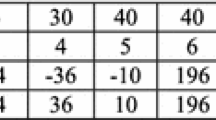Abstract
A content-based nonlinear filter capable of eliminating impulsively modeled artifacts from images and videos is proposed. The algorithm is a nonlinear filter that chooses median of the array or modified trimmed winsorized median of the array as the threshold to estimate the pixel is noisy or not. The median or modified winsorized median will act as a measure of central tendency to estimate the pixel is noisy or not. There are two demarcation levels used to conclude the estimated pixel is noisy or not. The first demarcation is named ad TH1 which holds value between (20 and 35). The second demarcation level is called TH2 which holds value between (0 and 15). The first delimiter says that the processed pixel is noisy or not and the second delimiter says that the median of the array is faulty or not. The proposed algorithm is applied on different defaced images and found to give very good visual results.
Access this chapter
Tax calculation will be finalised at checkout
Purchases are for personal use only
Similar content being viewed by others
References
Vijaykumar VR, Jothibasu P (2010) Decision based adaptive median filter to remove blotches, starches, streaks, stripes and impulsive noise in images. In: International conference on image processing, pp 117–120
Silva AU, Corte-Real L (1999) Removal of blotches and line scratches from film and video sequences using a digital restoration chain. In: Workshop on nonlinear signal and image, pp 826–829
Hanji G, Latte MV, Shweta NM (2012) An improved nonlinear decision based algorithm for removal of blotches and impulses in gray scale images. In: International conference on advanced computing and communication technologies, pp 240–244
Manikandhan S, Ebenezer D (2008) A nonlinear decision based algorithm for removal of strip lines, drop lines, blotches, band missing and impulses in images and videos. EURASIP J Image Video Process 485921:1–10
Kokaram A (1996) Detection and removal of line starches in the degraded motion pictures sequences. In: European signal processing conference, pp 5–8
Kaushik MK, Chandrakala GC, Abhinay R (2018) Ringing and blur artifact removal in image processing applications. In: International conference on intelligent computing and control systems (ICICCS), pp 260–264
Wang Z, Zhang D (1999) Progressive switching median filter for the removal of impulse noise from highly corrupted images. IEEE Trans Circ Syst 46:78–80
Akhtar M (2018) An adaptive algorithm based on modified tanh nonlinear and fractional processing for impulsive active noise control system. Sage J 37:495–508
Pandey R (2008) An improved switching median filter for uniformly distributed impulse noise removal. Int J Commun Eng 2(2):240–242
Srinivasan KS, Ebenezer D (2007) A new fast and efficient decision based algorithm for removal of high density impulse noises. IEEE Trans Sig Process 14:189–192
Xia J, Xiong J, Zhang Q (2010) An efficient two state switching median filter for the reduction of impulse noises with different distributions. In: 3rd international congress on image and signal processing, pp 639–644
Ibrahim H, Kong NSP, Ng TF (2008) Simple adaptive median filter for the removal of impulse noise from highly corrupted images. IEEE Trans Consum Electron 54(4):1920–1927
Ma C, Lv X, Ao J (2019) Difference based median filter for removal of random value impulse noise in images. Multimed Tools Appl 78:1131–1148
Hsieh MH, Cheng FC, Shie MC, Ruan SJ (2013) Fast and efficient median filter for removing 1–99% levels of salt-and-pepper noise in images. Eng Appl Artif Intell 26(4):1333–1338
Abhishek R, Srinivas N (2013) Removal of salt and pepper noise in image through weighted median filter. Int J Eng Res Technol 2(10):3587–3592
Zhang J (2010) An efficient median filter based method for removing random valued impulse noise. Digital Sig Process 20(4):1010–1018
Author information
Authors and Affiliations
Corresponding author
Editor information
Editors and Affiliations
Rights and permissions
Copyright information
© 2022 The Author(s), under exclusive license to Springer Nature Singapore Pte Ltd.
About this paper
Cite this paper
Kameswari, D.V.N., Divya, M., Vasanth, K., Pradeep Kumar Reddy, S., Nagaraj, S. (2022). Content-Based Nonlinear Filter for the Removal of Impulsively Modeled Artifacts from Images and Videos. In: Kumar Jain, P., Nath Singh, Y., Gollapalli, R.P., Singh, S.P. (eds) Advances in Signal Processing and Communication Engineering. Lecture Notes in Electrical Engineering, vol 929. Springer, Singapore. https://doi.org/10.1007/978-981-19-5550-1_7
Download citation
DOI: https://doi.org/10.1007/978-981-19-5550-1_7
Published:
Publisher Name: Springer, Singapore
Print ISBN: 978-981-19-5549-5
Online ISBN: 978-981-19-5550-1
eBook Packages: Mathematics and StatisticsMathematics and Statistics (R0)




